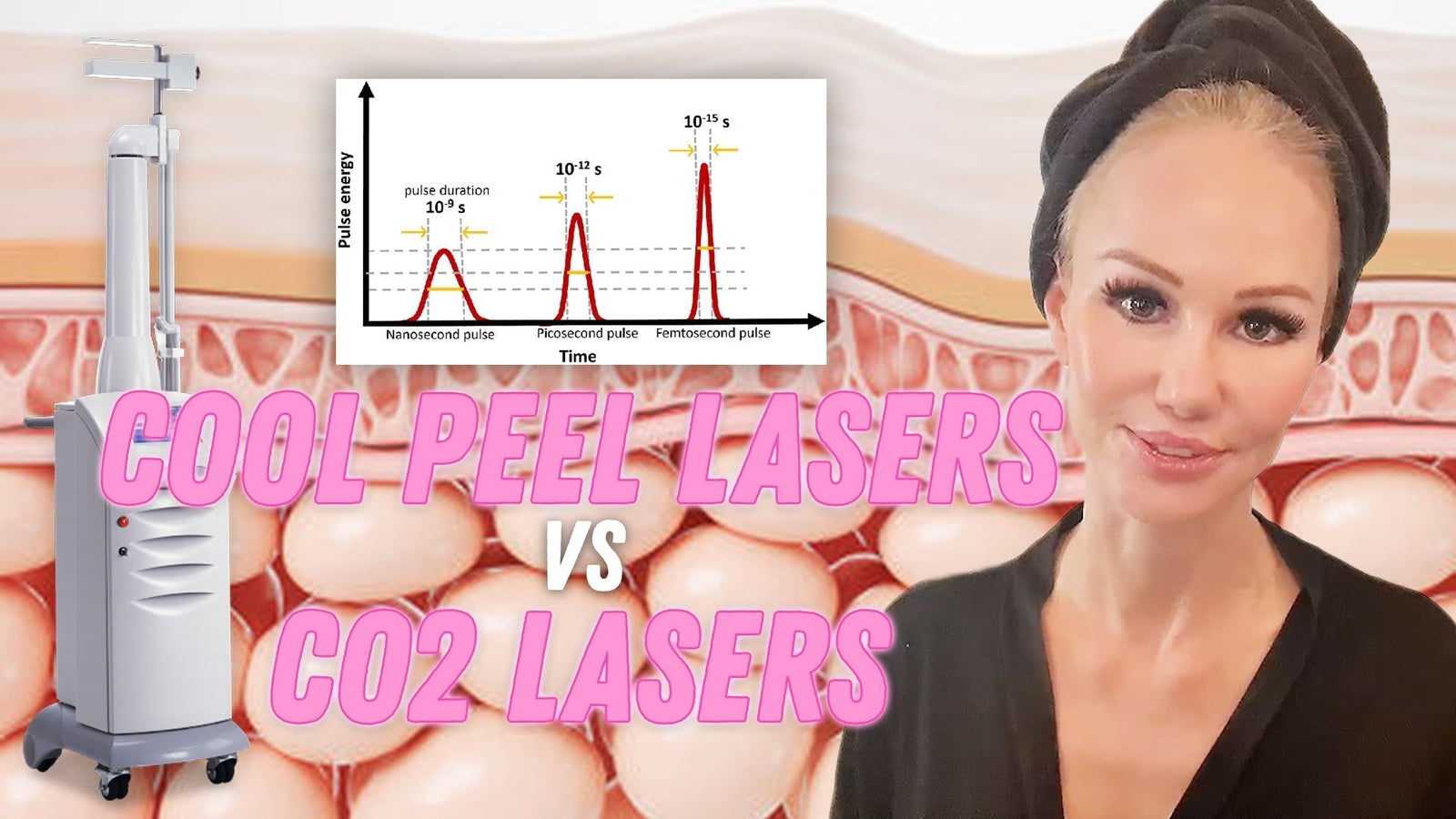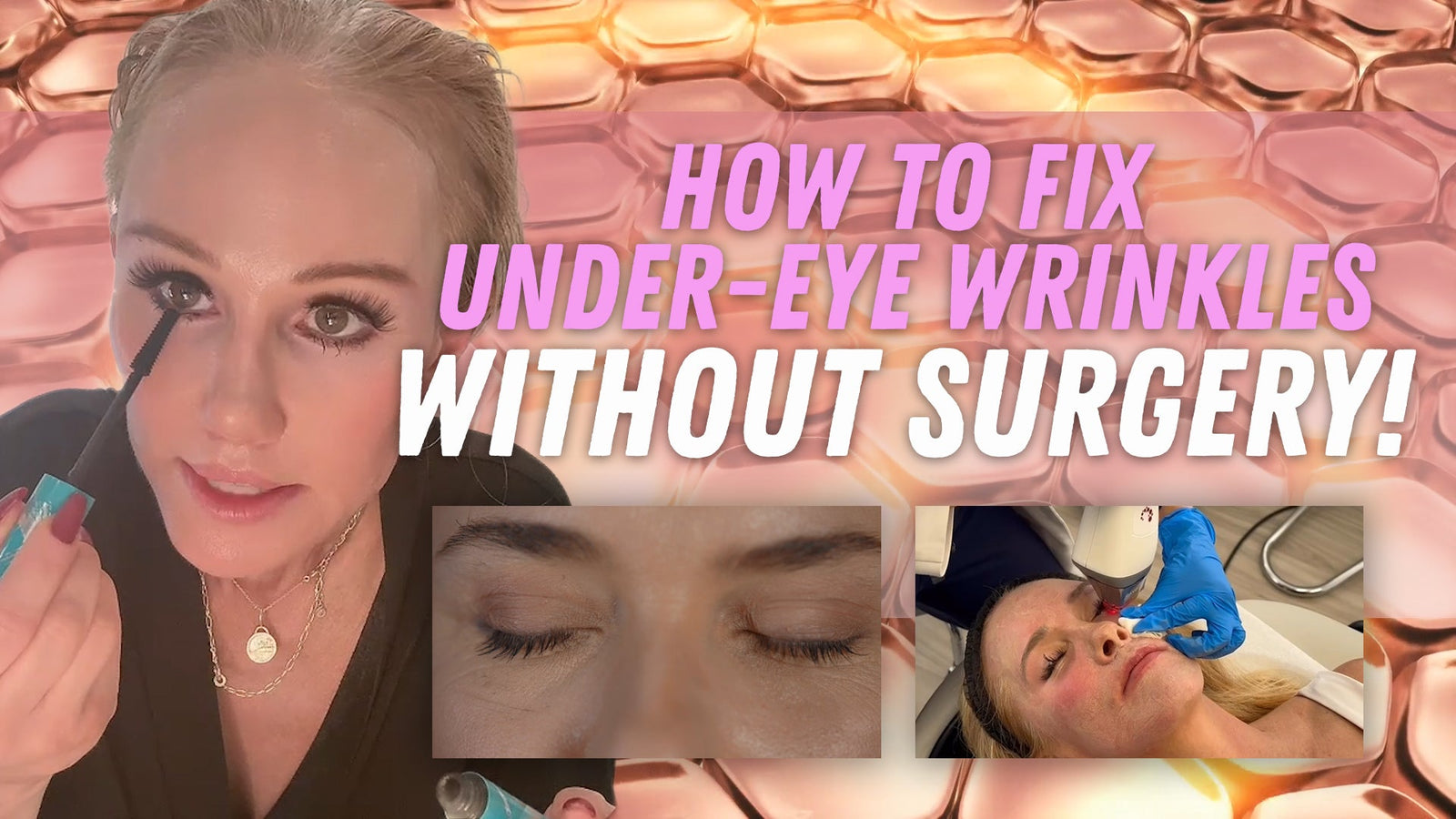Can You Erase Wrinkles, Tighten Skin, and Get a Mini Facelift with At-Home Devices?
Before you spend thousands of dollars on every new miracle device trending on the market, let me educate you about the science and technology behind many of these devices… how they work, if they work, and which ones are worth your time, money, and investment.
Plus, I’ll touch on the potential negative side effects that no one else wants to talk about.
Watch the corresponding YouTube video for a deep dive on at home face-lifting devices.
What is Microcurrent?
Microcurrent is a popular technology used in many at-home devices, such as the NuFACE. It works by sending electrical impulses and currents through the skin and subcutaneous tissue.
These impulses lift, tighten, and pull the skin, helping to define the jawline, lift the brow, minimize the appearance of fine lines and wrinkles, and tighten the skin.
How does Microcurrent “lift” the face?
The mechanism of action involves sending electrical impulses that cause muscular contraction. It's important to note that this doesn't affect the keratinocytes or skin cells directly but rather the thin muscles underneath the skin.
This muscular contraction leads to lifting, tightening, and smoothing out fine lines and wrinkles. However, this is not stimulating the skin to produce collagen as the mechanism of action is different than collagen stimulating procedures.
Effectiveness of Microcurrent
The main caveat with microcurrent technology is that the results are temporary. The effects are reversible, meaning you have to repeatedly use the device to sustain results.
The company claims the effects last one to three days, but in my experience with patients, most report the results lasting about 24 hours. It takes about 15 minutes a day to use the device effectively.
Does It Work?
In short, yes, microcurrent devices do work, but the results are temporary. If you have a big event or meeting and want to look your best, these devices can be a worthwhile investment.
However, for long-term results, they may not be the best option, especially considering the time commitment required.
What is Ultrasound in At-Home Devices?
Ultrasound or microfocused ultrasound is another technology used for skin tightening.
This technology uses sonic energy to generate heat, which stimulates fibroblasts – the collagen-producing cells in our skin. Collagen and elastin are proteins that give our skin its smooth, tight, and bouncy contour.
How Does Ultrasound tighten skin?
By applying heat through ultrasound, the fibroblasts are stimulated to produce more collagen and elastin. This can help to tighten and firm the skin.
However, the amount of heat required to penetrate the epidermis and reach the dermis (where fibroblasts reside) can sometimes cause side effects like thermal burns, nerve damage, or fat demyelination (damage to the fat that surrounds the nerves).
Ultrasound risks & effectiveness
At-home devices typically don’t generate enough heat to induce dramatic changes because they must avoid causing harm to the consumer.
Professional devices like Ultherapy or Sofwave are more effective but must be used with caution to avoid side effects. At-home ultrasound devices may provide some benefits, but they are limited in their effectiveness and carry risks if not used correctly.
What is Thermal Activation?
Thermal activation refers to the use of heat from any energy source, such as ultrasound, radiofrequency, or microwave technology, to stimulate collagen synthesis.
By heating the skin, you create a controlled wound healing environment, which leads to upregulation of collagen production.
Challenges with At-Home Devices
The primary challenge with at-home thermal activation devices is delivering sufficient heat to stimulate collagen without damaging the skin. The epidermis must be protected from overheating, which can cause hyperpigmentation, burns, and other side effects.
Professional devices, like Thermage, have built-in cooling mechanisms to protect the epidermis while delivering targeted heat to the dermis.
In-Office vs. At-Home Devices
In-office procedures are stronger, more powerful, and more regulated compared to at-home devices.
They are also more specific and elegant, making them safer and more effective.
At-home devices, while more convenient and affordable, often lack the strength to induce significant collagen stimulation without risking side effects.
At-Home Radiofrequency Devices
Radiofrequency (RF) devices use energy to heat the skin, stimulating collagen production. This can help to smooth fine lines, tighten the skin, and reduce wrinkles.
Effectiveness and Safety of Radio Frequency
In-office RF treatments are more powerful and effective than at-home devices. The latter cannot generate sufficient heat to induce significant changes without risking skin damage.
Professional treatments are administered by trained providers who understand the physics and physiological responses of the skin, ensuring safer and more effective outcomes.
Temporary vs. Long-Term Results
At-home devices, including microcurrent and ultrasound, can provide temporary improvements in skin appearance.
However, they require consistent use and may not be suitable for those seeking long-term, sustainable results.
Professional treatments offer more significant and lasting benefits but come at a higher cost and require office visits.Knowledge is power. Understanding how these devices work, their limitations, and potential risks is crucial before investing time and money.
For temporary, short-term results, at-home devices can be effective.
For long-lasting changes, professional treatments are recommended.

Time investment of at home devices vs in office procedures
At-home devices, such as the popular NuFace microcurrent device, offer the convenience of daily treatments in the comfort of your home. These devices can temporarily improve the appearance of your skin by tightening muscles and offering a quick fix.
However, they do require a significant time investment—approximately 15 minutes each day, which sums up to over 90 hours a year. The results, while noticeable, are not long-term and require consistent use to maintain.
For those who prefer a more permanent solution, in-office treatments might be more appealing. Procedures like laser resurfacing and Thermage use advanced technology to stimulate collagen production, addressing the root cause of wrinkles and sagging skin. Unlike at-home devices, the results from these treatments can last several years.
For example, Thermage results can last up to 5-6 years, with skin improvements continuing for up to a year post-treatment.
At home “laser” cautions (LYMA and NIRA)
At-home devices often promise significant results, claiming to stimulate collagen, reduce fine lines, wrinkles, and even brown spots. However, it's essential to approach these claims with caution.
Many of these devices do not undergo the same rigorous testing and regulatory scrutiny as professional-grade equipment. The data and clinical trials presented by manufacturers can be misleading, often funded by the companies themselves with a strong marketing agenda.
This can result in consumers spending a substantial amount of money on devices that fail to deliver the promised results and sometimes cause complications like hyperpigmentation, especially in darker skin tones.
For instance, devices like the LYMA laser and the NIRA laser are marketed heavily and endorsed by influencers, but their effectiveness remains questionable. The cost of these devices can be as high as $2,695, which is more than many in-office procedures.
With the lack of regulation in the industry means there is no accountability for the claims made by these products. When complications arise, customers often find it challenging to get refunds or support from the manufacturers.
In-Office Treatments
In contrast, professional treatments performed in dermatology offices use highly potent, regulated devices. These treatments, such as those done with Pico lasers, are not only more effective but also more cost-efficient in the long run.
The initial expense of an in-office treatment, which can range from $900 to $1,200 per session, is often less than the cumulative cost of at-home devices and the subsequent treatments needed to correct any adverse effects.
At-home devices like the NuFace microcurrent device may not cause harm, but their results are temporary and require consistent, time-consuming use.
On the other hand, complications from at-home lasers, like the NIRA or LYMA, can lead to significant costs to correct issues such as hyperpigmentation or fat loss. These complications might necessitate treatments with professional-grade lasers, which are much more effective and provide lasting results.
Marketing Deception
It's crucial to be cautious of marketing tactics that use terms like "award-winning" or "dermatologist-approved." These claims often lack backing from credible medical bodies such as the American Academy of Dermatology or the American Society for Dermatologic Surgery.
As a consumer, it's essential to look for treatments that have undergone thorough clinical testing and have received approval from reputable medical organizations. When considering an investment in skin treatments, prioritize products and procedures that have proven efficacy and safety.
For instance, medical-grade skincare products can offer substantial benefits without the risks associated with at-home devices. Products designed by professionals ensure quality and effectiveness.
Consider your goals, budget, and willingness to commit to a daily routine before making a decision. Always prioritize safety and efficacy when choosing skincare devices.
Ultimately, whether you choose an at-home device or an in-office procedure depends on your personal preferences, budget, and the type of results you seek.
In-office treatments, while more expensive upfront, offer lasting benefits and are performed under professional supervision, minimizing risks.
For those looking for reliable, long-term solutions, professional treatments are generally the better option. Investing in quality skincare and professional advice will likely yield better results than relying on heavily marketed at-home devices.
If you’re looking for an MDAiRE product with to help anti aging, youthful glow, and hydration, check out our product line!



